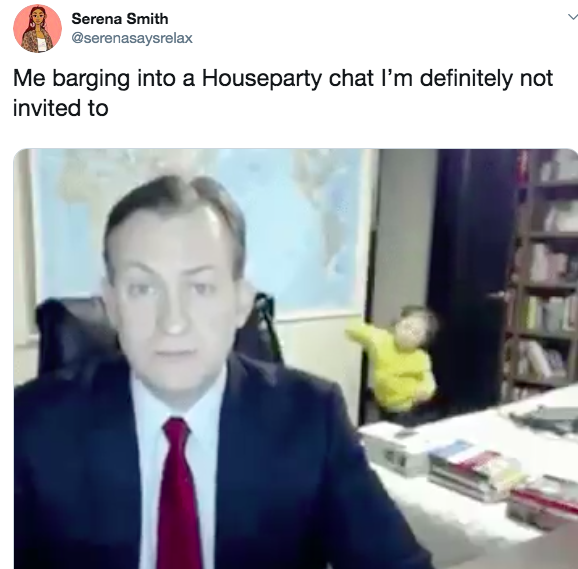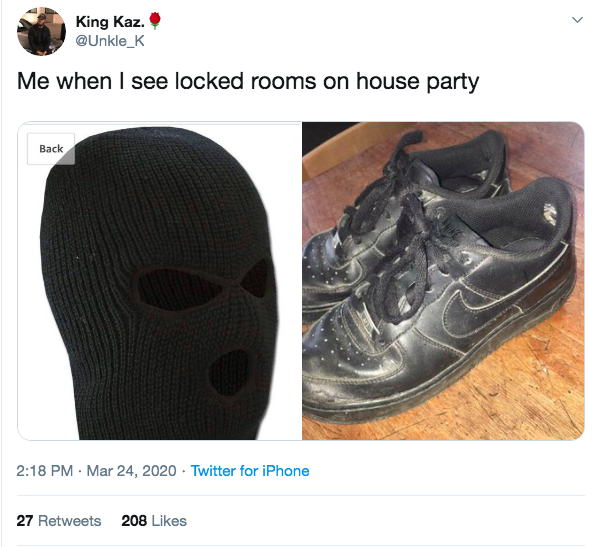Thursday was the first big night of the week.
By the early evening, I was chatting with the director of a big global gallery over drinks when we bumped into a friend of mine, a prominent artist. It wasn’t an artist the gallery director showed, but it turned out they knew each other in college. Later, I had plans to catch up with an art advisor during dinner, and a director at a space in Chelsea was around, so he joined too. There was a lot of good wine. Friday was even busier. A director of a European gallery and I watched as a married couple, two artists, mixed martinis. “Nate, just a rinse of vermouth, right?” one artist asked, shaker in hand. Saturday, there was a raucous surprise party feting the owner of a hip Brooklyn gallery. After a few drinks, the gallery owner donned a Warhol wig and started jumping rope in the corner of the room.
Of course all of this—the serendipitous bump-ins, the coincidental same-place-same-time collisions—happened remotely. I was in the Catskills, while others were in towns in the Hudson River Valley, or inhabiting fireplace-laden cottages in Connecticut hamlets, or safely ensconced in safe houses down south, or hunkered down in Brooklyn brownstones, or in Noho lofts having not left for more than a week.
Yes, the insatiably social art-world milieu has found a place to frolic free during our current plague quarantine. The oh-so-generous host is an app called Houseparty no one had ever heard of two weeks ago.

A Complete and Total Shitshow
There are a lot of video chat apps that have become as indispensable as a limb overnight. We have meetings on Zoom (which—no surprise—was valued at $44.5 billion on Tuesday, beating out an increasingly obsolete Uber) and gabfests with family and friends on Google Hangouts, where we eat dinner together. Hey, it’s almost like it’s Christmas.
Houseparty is not like Christmas. It’s like being at a shitshow soirée, maybe even a great shitshow soirée, maybe even an on-the-verge-of-catastrophe-great shitshow soirée. At best, it’s redolent of a place like the notorious cigarette-smoke-clogged art-damaged hang China Chalet, and I’m not just saying that because most of the people on Houseparty were at that China Chalet party a few weeks back that, really, feels like years ago.
You sign up, innocently, and then all of a sudden, you don’t even have to fire up the app to be lured in. If you enable notifications (everyone enables notifications) you get pinged every time one of your friends comes on. The notifications are enthusiastic. For example: “? Alberto Mugrabi is in the House!” You also get a ping each time someone from your contacts joins Houseparty—and the rate at which new people are joining is increasing day by day. As I was writing this sentence, a friend logged in, and when I got on the app and connected, he was at the top of a mountain. He’d literally climbed to the top of a run that had closed the lifts, skis on his back, and was getting ready to ride down. Like I said, a great shitshow soirée.
But there’s one feature that really sets Houseparty apart from the let’s-circle-back-tomorrow video-conference software, and it starts with the scrolling feed.
The scrolling feed shows all your Houseparty friends who are currently online, but also who they’re hanging out with, and at any point, you can bum-rush their conversations, even if you’ve never met that other person in your life. Crashers welcome. Suddenly, it’s your face in a box, and then a lot of other faces in boxes, with maybe one face you know, but others you do not know—just like a real-life party.
There’s a way to lock the room, and it’s bitchy. On the feed, it’ll show that a room’s locked—but still tell you who is in the room. So, if you see a locked room with your friends in it, it means that someone’s not inviting you.
But it’s when people don’t lock the room that Houseparty gets fun. To be the active crasher is thrilling. You parachute in, mid-sentence, and your face pops up on the phones of seven semi or complete strangers around the world. (It’s eight to a room, max.)
To be chilling in your digs when it gets crashed is deeply unsettling. But afterward, you savor that dissonance and realize you really miss it in a world where you aren’t allowed to leave your house or get within six feet of another person.
“Houseparty is uncanny to the act of going to an art opening,” said James Michael Cardoso Shaeffer, the director of Greene Naftali, the Chelsea gallery. “Out of curiosity, or necessity, you open the app much like you may begrudgingly, or out of habit, go to an art opening. Once ‘in,’ you are immediately confronted with nonconsensual interactions you may or may not want to engage with. The social anxiety is the same, the platform is different. Amazing that technology offers us continued practice on how to cleverly leave a conversation.”

Come In and Stay a While!
Houseparty rose from the ashes of another video chat app, Meerkat, which was put to pasture in 2016 just weeks after a high-profile launch at South by Southwest. When announcing the shutdown, Meerkat founder Ben Rubin introduced a new venture, one started with former Tumblr and Yahoo exec Sima Sistani, called Houseparty.
While Meerkat was focused on broadcasting through social media, Houseparty was a pivot, one that bet on private, not public, messaging. But Rubin didn’t want it to be too private. He told Fast Company that he wanted it to be a more casual, drop-in, drop-out version of conferencing apps.
“We wanted a place where you could casually meet 20 people you care about without having to schedule anything,” he told Fast Company in 2017. “You don’t need to set up a call and feel awkward for FaceTiming somebody.”
The app quickly had a million daily active users, and by 2017, that number had doubled. Rubin left in April 2019 to be entrepreneur in residence at Benchmark, a venture capital firm. Sistani is now Houseparty’s CEO.
(Through a press rep, leadership declined to comment. “We would like to be sensitive to what’s going on in the world so we won’t be doing interviews about Houseparty usage during this global pandemic,” the representative said.)
In June 2019, Houseparty was acquired by Epic Games, the maker of Fortnite, the online video game that has attracted hundreds of millions of users in its short period of domination. Because the game only had a voice chat function, Houseparty would become the means by which players could talk “face-to-face” while shooting the bejesus out of the bad guys (or whatever it is people do on Fortnite). Sistani admitted in a tweet that, going forward, such was Houseparty’s fate.
But that fate changed drastically earlier this year. On January 10—the day before the first coronavirus death in Wuhan—the Houseparty app was ranked 704 in the global ranking of free iPhone apps. Shortly thereafter, it began to rise. In March, it entered the top 200, and on Monday, March 16, when bars and restaurants in New York City were forced to close by the state government, it was ranked 115. By last Sunday, it was ranked 8.

Like Chatroulette, Without the Dicks
While Zoom may be the best place to replicate the tenor and tempo of a corporate powwow, the art world needed a platform that actively embraces chaos and abject shit-talking.
“Last night I was having an epic gossip session with some friends and was thrilled to have the lock function,” said a New York art dealer who wished to remain anonymous. “Then we unlocked the doors once our grievances and wild speculations were aired and a bunch of other friends joined and it gave a comforting sense of normalcy. My friends and their core personalities are still intact.”
“Also, love seeing who my ex is talking too,” the dealer said, speaking to another inevitability of a fairly incestuous scene.
Others craved it just to have variables in an increasingly monotonous life—even if these variables are the ones that, in the old world, would have been extremely annoying.
“Houseparty satisfies the constant, desperate need I have to be doing something, to be meeting people I don’t know, and to be communicating with people I will quite probably never see or speak to again,” said a senior account executive at an art-centric public relations firm.
“It’s like Chatroulette without the dicks,” said a New York-based spokesperson for an arts nonprofit. “But I expect that to change as isolation continues.”
“It has all the charm of a real house party, but no one has to wear underwear,” said a source who works in art publishing.
“I’ve sold $10,000 in work on Houseparty,” said the art dealer Ellie Rines, who runs the Manhattan gallery 56 Henry. “It’s better than an online viewing room.”
Or, as the artist Zak Kitnick put it, “I’ll never forget my first time.”
And indeed, the potential to meet new people on Houseparty is only increasing. By Tuesday, a large chunk of my close friends in the art sphere had joined. And not-yet-friends the algorithm pushed on me included famous curators, prominent New York gallery owners, fashion designers who show at Paris Fashion Week, artists in the Whitney Biennial, and Tico Mugrabi.
But after days of using it—hopping into rooms, having glamorous friends-of-friend crash into convos—something was missing. Houseparty feels like you’re hanging out with the art world, but at the end of the day, when you log off, you’re alone and stuck in your apartment.
“I kind of love and hate Houseparty,” said the art advisor Daniel Oglander. “It affords one the ability to stay in contact with colleagues and friends, but always reminds me of what I’m missing after the call is over.”
“Human contact is irreplaceable,” he added. “And I miss hugs, damn it.”










